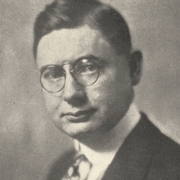Clarence L. Meisinger (1895–1924)
Clarence Leroy Meisinger was born at Plattsmouth, Nebraska on April 30, 1895. He graduated from the University of Nebraska in 1917 with the degree of BSc, and subsequently took degrees of MS and PhD at George Washington University. During World War I, he served in the Army and by the end of the war had become a second lieutenant in the Meteorological Section of the Signal Corps and had already won a reputation as a balloonist and a student of aeronautical meteorology.
Employed at the U.S. Weather Bureau as an observer in September, 1919, he was assigned to duty at the Central Office, and was detailed to the office of the Editor. He retained this detail throughout the period of his service in the bureau, and at the same time carried on a number of important investigations in the field of aerology and aeronautical meteorology. His principal work was the development of a method for computing pressures and winds at certain heights above the ground; he presented the results of his work at the 1923 meeting of the American Meteorological Society. Additionally, his work on barometric hypsometry has been pronounced as the outstanding scientific contribution presented at this or any other meeting of the society.
In connection with these studies Dr. Meisinger recommended making manned balloon flights in order to obtain first hand observations were to be made of such conditions as the amount of dust in the air, sky brightness, and size of cloud droplets.
Dr. Meisinger, a licensed pilot himself, made an ascent in a large balloon with another pilot on June 2, 1924, and are believed to have been lost in a thunderstorm.
